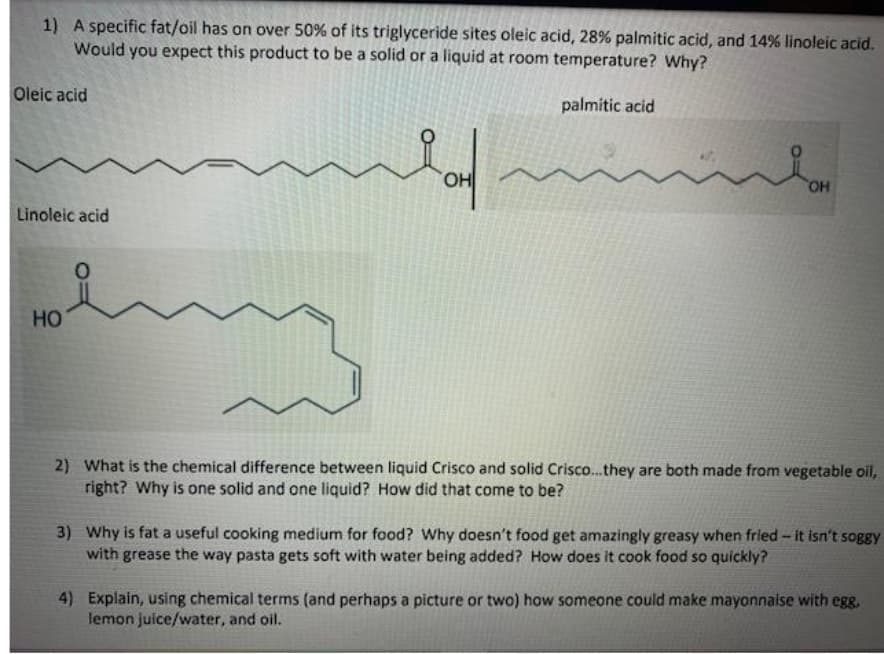1) A specific fat/oil has on over 50% of its triglyceride sites oleic acid, 28% palmitic acid, and 14% linoleic acid. Would you expect this product to be a solid or a liquid at room temperature? Why? Oleic acid palmitic acid HO HO Linoleic acid но
1) A specific fat/oil has on over 50% of its triglyceride sites oleic acid, 28% palmitic acid, and 14% linoleic acid. Would you expect this product to be a solid or a liquid at room temperature? Why? Oleic acid palmitic acid HO HO Linoleic acid но
Biochemistry
9th Edition
ISBN:9781319114671
Author:Lubert Stryer, Jeremy M. Berg, John L. Tymoczko, Gregory J. Gatto Jr.
Publisher:Lubert Stryer, Jeremy M. Berg, John L. Tymoczko, Gregory J. Gatto Jr.
Chapter1: Biochemistry: An Evolving Science
Section: Chapter Questions
Problem 1P
Related questions
Question
Give answer all questions with explanation please

Transcribed Image Text:1) A specific fat/oil has on over 50% of its triglyceride sites oleic acid, 28% palmitic acid, and 14% linoleic acid.
Would you expect this product to be a solid or a liquid at room temperature? Why?
Oleic acid
palmitic acid
HO.
Linoleic acid
HO
2) What is the chemical difference between liquid Crisco and solid Crisco.they are both made from vegetable oil,
right? Why is one solid and one liquid? How did that come to be?
3) Why is fat a useful cooking medium for food? Why doesn't food get amazingly greasy when fried - it isn't soggy
with grease the way pasta gets soft with water being added? How does it cook food so quickly?
4) Explain, using chemical terms (and perhaps a picture or two) how someone could make mayonnaise with egg.
lemon juice/water, and oil.
Expert Solution
This question has been solved!
Explore an expertly crafted, step-by-step solution for a thorough understanding of key concepts.
Step by step
Solved in 2 steps

Knowledge Booster
Learn more about
Need a deep-dive on the concept behind this application? Look no further. Learn more about this topic, biochemistry and related others by exploring similar questions and additional content below.Recommended textbooks for you

Biochemistry
Biochemistry
ISBN:
9781319114671
Author:
Lubert Stryer, Jeremy M. Berg, John L. Tymoczko, Gregory J. Gatto Jr.
Publisher:
W. H. Freeman

Lehninger Principles of Biochemistry
Biochemistry
ISBN:
9781464126116
Author:
David L. Nelson, Michael M. Cox
Publisher:
W. H. Freeman

Fundamentals of Biochemistry: Life at the Molecul…
Biochemistry
ISBN:
9781118918401
Author:
Donald Voet, Judith G. Voet, Charlotte W. Pratt
Publisher:
WILEY

Biochemistry
Biochemistry
ISBN:
9781319114671
Author:
Lubert Stryer, Jeremy M. Berg, John L. Tymoczko, Gregory J. Gatto Jr.
Publisher:
W. H. Freeman

Lehninger Principles of Biochemistry
Biochemistry
ISBN:
9781464126116
Author:
David L. Nelson, Michael M. Cox
Publisher:
W. H. Freeman

Fundamentals of Biochemistry: Life at the Molecul…
Biochemistry
ISBN:
9781118918401
Author:
Donald Voet, Judith G. Voet, Charlotte W. Pratt
Publisher:
WILEY

Biochemistry
Biochemistry
ISBN:
9781305961135
Author:
Mary K. Campbell, Shawn O. Farrell, Owen M. McDougal
Publisher:
Cengage Learning

Biochemistry
Biochemistry
ISBN:
9781305577206
Author:
Reginald H. Garrett, Charles M. Grisham
Publisher:
Cengage Learning

Fundamentals of General, Organic, and Biological …
Biochemistry
ISBN:
9780134015187
Author:
John E. McMurry, David S. Ballantine, Carl A. Hoeger, Virginia E. Peterson
Publisher:
PEARSON